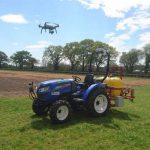 Despite its somewhat old fashioned image, farming has been one of the most willing adopter of new technologies, whether it’s the use of drones to monitor soil health, wearable devices to track livestock, or the general automation of tasks such as harvesting and picking.
Despite its somewhat old fashioned image, farming has been one of the most willing adopter of new technologies, whether it’s the use of drones to monitor soil health, wearable devices to track livestock, or the general automation of tasks such as harvesting and picking.
A great example of what is technologically possible comes via Hands Free Hectare, a collaborative project between Harper Adams University and tech startup Precision Decisions. It utilizes autonomous vehicles and drones to do everything from planting to tending all the way through to harvesting, which is also automated.
The successful prototype managed to yield 4.5 tons of barley, which whilst slightly below the predicted yield of 5 tons, was still a successful demonstration of how entire crops can be grown from start to finish without needing human input. As such, the team believe this to be the first demonstration of this kind, and therefore hugely significant.
Hands free farming
The team used a number of pieces of equipment during the trial. For instance, an Iseki tractor performed the spraying, drilling and rolling work, with a Sampo combine harvester then utilized.
Providing continuous aerial support was a fleet of drones that utilized multispectral and RGP sensors to take images of the field. A smaller Scout vehicle then provided video footage at the crop level, whilst was also capable of taking physical samples that were analyzed by an agronomist to determine what chemical support was needed and when crops should be harvested.
What makes the project interesting is that all of the equipment used is already readily available to farmers. What’s more, all of the technology is open source.
The team believe that in the future, farmers will utilize fleets of small, autonomous vehicles that will do the physical work in the field, thus allowing the farmer to be very efficient in their use of time.
What’s more, the whole project was completed for under £200,000, highlighting what can be achieved with relatively small amounts of investment.
“This project aimed to prove that there’s no technological reason why a field can’t be farmed without humans working the land directly now and we’ve done that. We set-out to identify the opportunities for farming and to prove that it’s possible to autonomously farm the land, and that’s been the great success of the project,” the team say.
Check out the video below to learn more about the project.